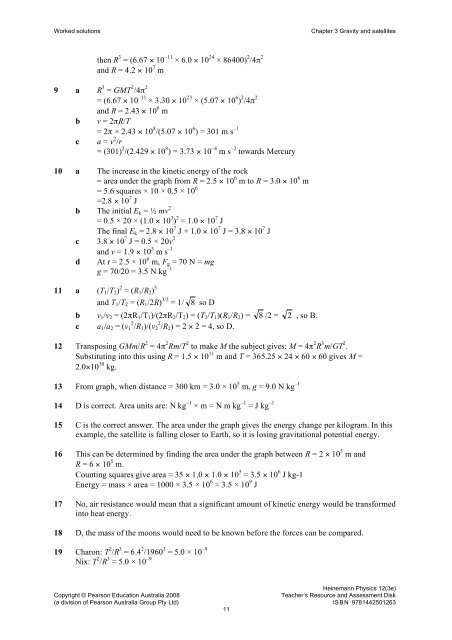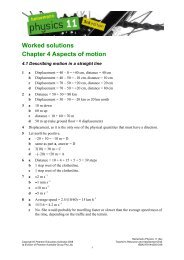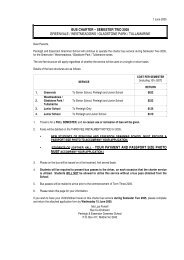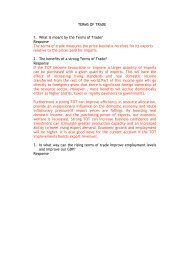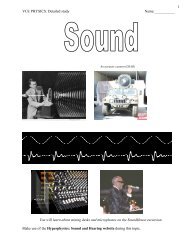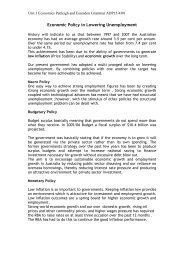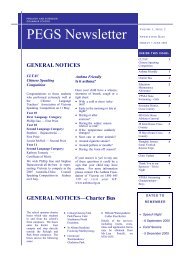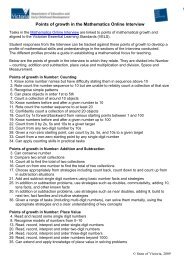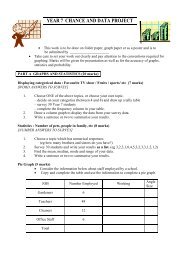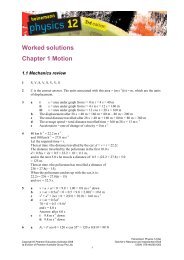Worked solutions Chapter 3 Gravity and satellites - PEGSnet
Worked solutions Chapter 3 Gravity and satellites - PEGSnet
Worked solutions Chapter 3 Gravity and satellites - PEGSnet
You also want an ePaper? Increase the reach of your titles
YUMPU automatically turns print PDFs into web optimized ePapers that Google loves.
<strong>Worked</strong> <strong>solutions</strong><strong>Chapter</strong> 3 <strong>Gravity</strong> <strong>and</strong> <strong>satellites</strong>then R 3 = (6.67 × 10 –11 × 6.0 × 10 24 × 86400) 2 /4π 2<strong>and</strong> R = 4.2 × 10 7 m9 a R 3 = GMT 2 /4π 2= (6.67 × 10 –11 × 3.30 × 10 23 × (5.07 × 10 6 ) 2 /4π 2<strong>and</strong> R = 2.43 × 10 8 mb v = 2πR/T= 2π × 2.43 × 10 8 /(5.07 × 10 6 ) = 301 m s –1c a = v 2 /r= (301) 2 /(2.429 × 10 8 ) = 3.73 × 10 –4 m s –2 towards Mercury10 a The increase in the kinetic energy of the rock= area under the graph from R = 2.5 × 10 6 m to R = 3.0 × 10 6 m= 5.6 squares × 10 × 0.5 × 10 6=2.8 × 10 7 Jb The initial E k = ½ mv 2= 0.5 × 20 × (1.0 × 10 3 ) 2 = 1.0 × 10 7 JThe final E k = 2.8 × 10 7 J + 1.0 × 10 7 J = 3.8 × 10 7 Jc 3.8 × 10 7 J = 0.5 × 20v 2<strong>and</strong> v = 1.9 × 10 3 m s –1d At r = 2.5 × 10 6 m, F g = 70 N = mgg = 70/20 = 3.5 N kg –111 a (T 1 /T 2 ) 2 = (R 1 /R 2 ) 3<strong>and</strong> T 1 /T 2 = (R 1 /2R) 3/2 = 1/8 so Db v 1 /v 2 = (2πR 1 /T 1 )/(2πR 2 /T 2 ) = (T 2 /T 1 )(R 1 /R 2 ) = 8 /2 = 2 , so B.c a 1 /a 2 = (v 2 1 /R 1 )/(v 2 2 /R 2 ) = 2 × 2 = 4, so D.12 Transposing GMm/R 2 = 4π 2 Rm/T 2 to make M the subject gives: M = 4π 2 R 3 m/GT 2 .Substituting into this using R = 1.5 × 10 11 m <strong>and</strong> T = 365.25 × 24 × 60 × 60 gives M =2.0×10 30 kg.13 From graph, when distance = 300 km = 3.0 × 10 5 m, g = 9.0 N kg –114 D is correct. Area units are: N kg –1 × m = N m kg –1 = J kg –115 C is the correct answer. The area under the graph gives the energy change per kilogram. In thisexample, the satellite is falling closer to Earth, so it is losing gravitational potential energy.16 This can be determined by finding the area under the graph between R = 2 × 10 5 m <strong>and</strong>R = 6 × 10 5 m.Counting squares give area = 35 × 1.0 × 1.0 × 10 5 = 3.5 × 10 6 J kg-1Energy = mass × area = 1000 × 3.5 × 10 6 = 3.5 × 10 9 J17 No, air resistance would mean that a significant amount of kinetic energy would be transformedinto heat energy.18 D, the mass of the moons would need to be known before the forces can be compared.19 Charon: T 2 /R 3 = 6.4 2 /1960 3 = 5.0 × 10 –9Nix: T 2 /R 3 = 5.0 × 10 –9Heinemann Physics 12(3e)Copyright © Pearson Education Australia 2008Teacher’s Resource <strong>and</strong> Assessment Disk(a division of Pearson Australia Group Pty Ltd) ISBN 978144250126311


